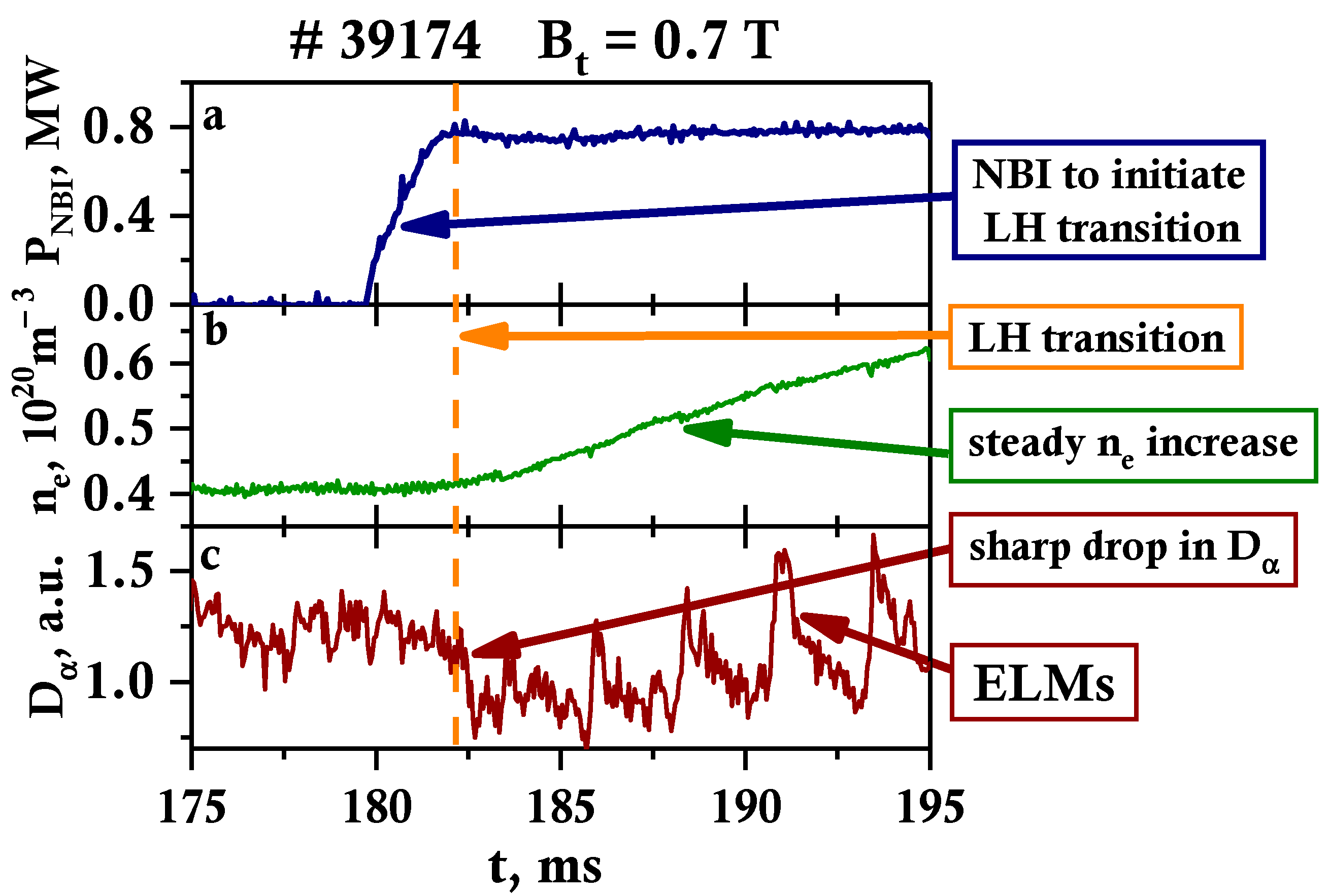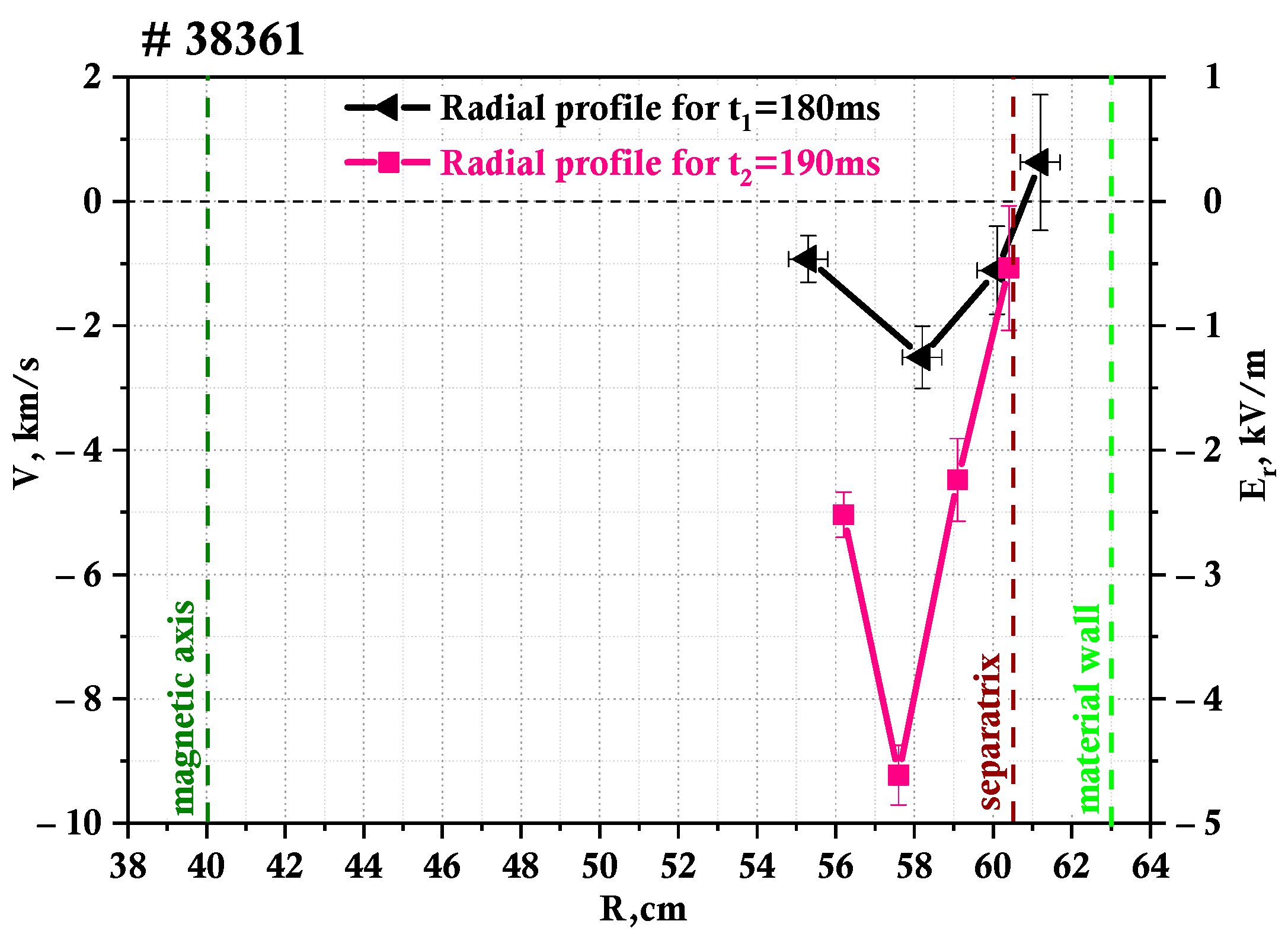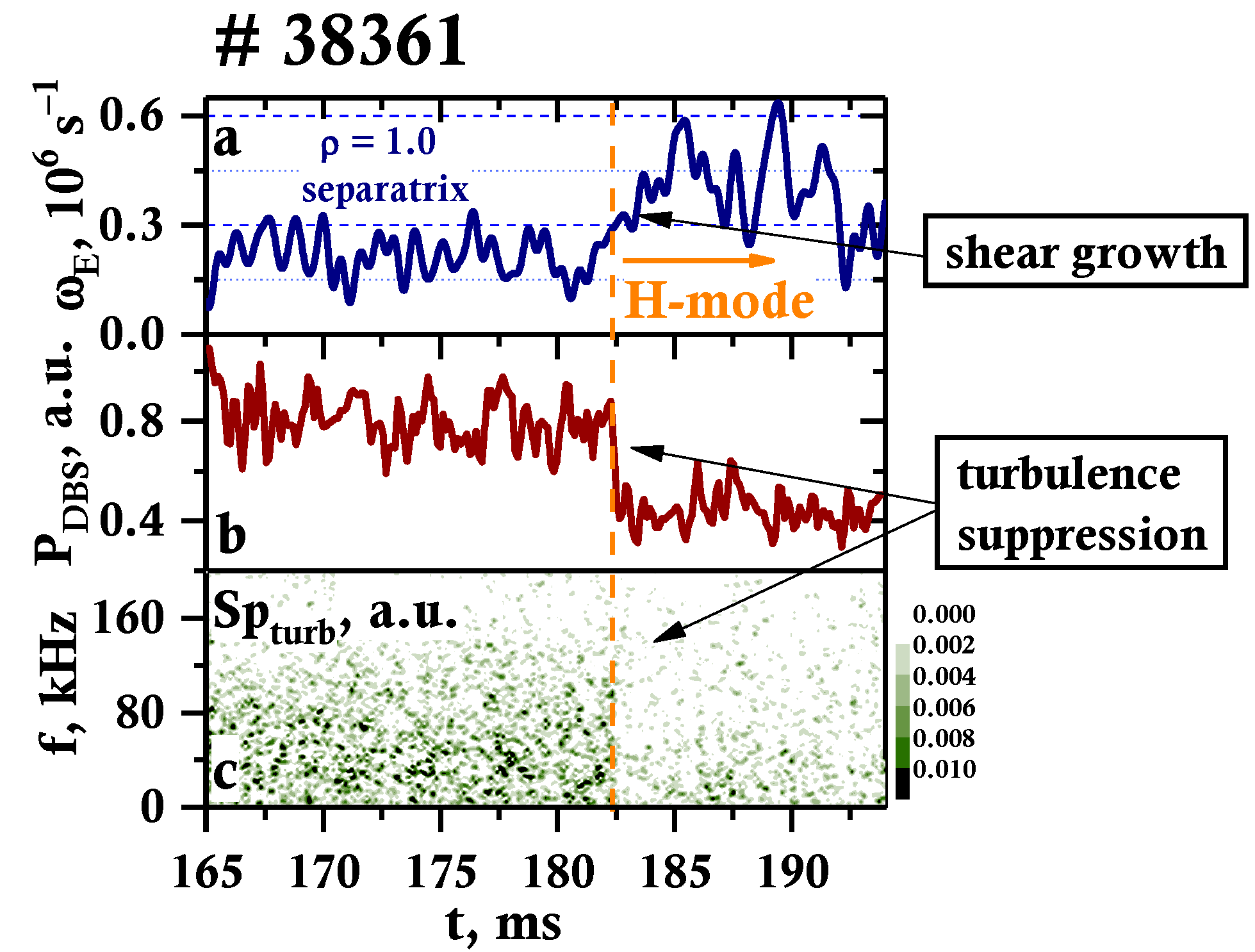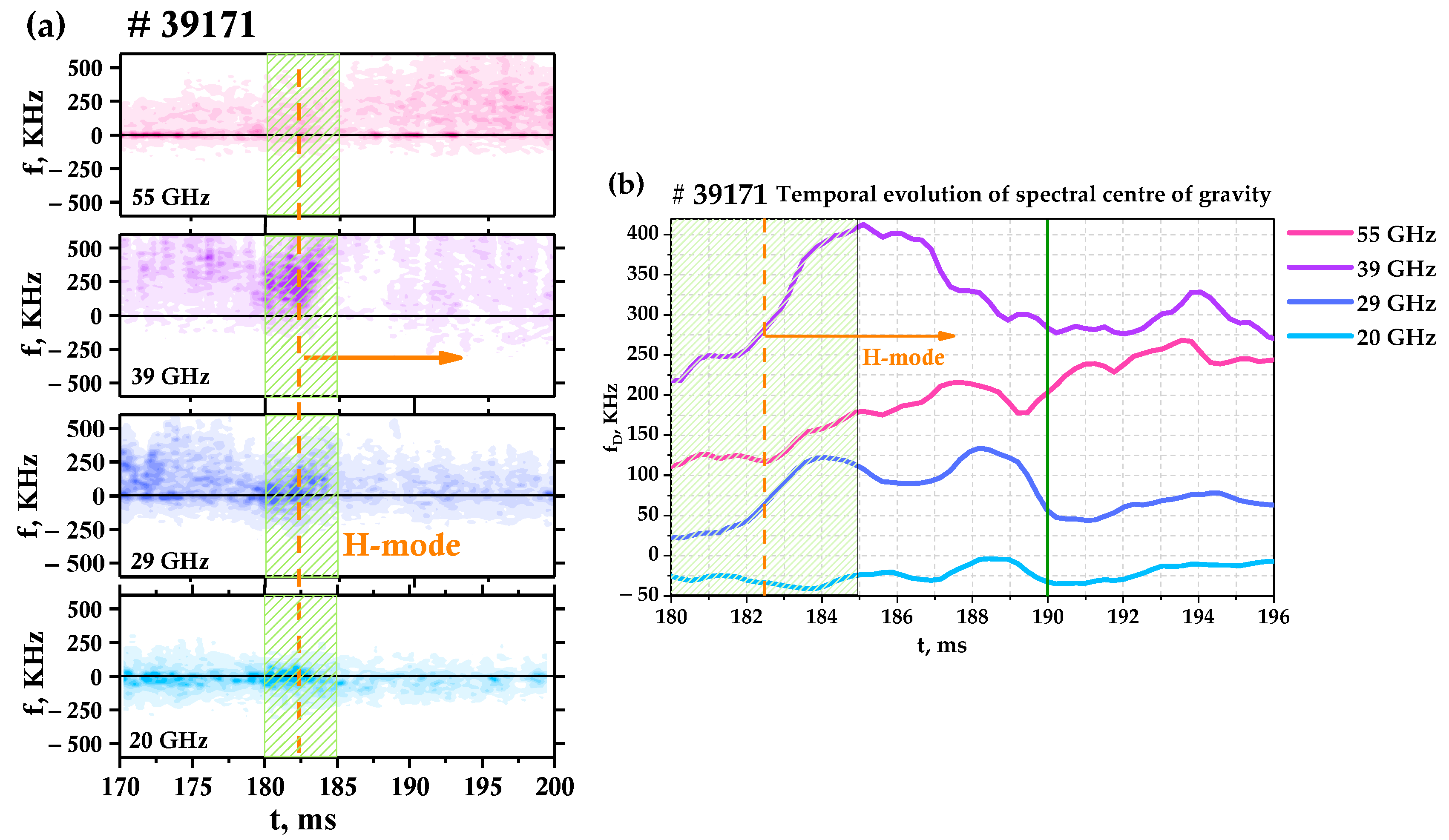First Results of the Implementation of the Doppler Backscattering Diagnostic for the Investigation of the Transition to H-Mode in the Spherical Tokamak Globus-M2
Abstract
:1. Introduction
2. Doppler Backscattering
2.1. Doppler Backscattering to Study the LH Transition and the H-Mode
3. LH Transition and H-Mode on Globus-M2
3.1. Velocity Behavior during the LH Transition
3.2. Turbulence Behavior during the LH Transition
4. Summary
Author Contributions
Funding
Institutional Review Board Statement
Informed Consent Statement
Data Availability Statement
Acknowledgments
Conflicts of Interest
References
- Donné, A.J.H.; Costley, A.E.; Barnsley, R.; Bindslev, H.; Boivin, R.; Conway, G.; Fisher, R.; Giannella, R.; Hartfuss, H.; Hellermann, M.G.; et al. Chapter 7: Diagnostics. Nucl. Fusion 2007, 47, S337. [Google Scholar] [CrossRef] [Green Version]
- Wagner, F.; Becker, G.; Behringer, K.; Campbell, D.; Eberhagen, A.; Engelhardt, W.; Fussmann, G.; Gehre, O.; Gernhardt, J.; Gierke, G.V.; et al. Regime of Improved Confinement and High Beta in Neutral-Beam-Heated Divertor Discharges of the ASDEX Tokamak. Phys. Rev. Lett. 1982, 49, 1408. Available online: https://journals.aps.org/prl/abstract/10.1103/PhysRevLett.49.1408. (accessed on 10 July 2022). [CrossRef]
- Doyle, E.J.; Houlberg, W.A.; Kamada, Y.; Mukhovatov, V.; Osborne, T.H.; Polevoi, A.; Bateman, G.; Connor, J.W.; Cordey, J.G.; Fujita, T.; et al. Chapter 2: Plasma confinement and transport. Nucl. Fusion 2007, 47, S18. Available online: https://iopscience.iop.org/article/10.1088/0029-5515/47/6/S02. (accessed on 10 July 2022).
- Wagner, F. A quarter-century of H-mode studies. Plasma Phys. Control. Fusion 2007, 49, B1. Available online: https://iopscience.iop.org/article/10.1088/0741-3335/49/12B/S01/meta. (accessed on 10 July 2022). [CrossRef]
- Burrell, K.H. Tests of causality: Experimental evidence that sheared E × B flow alters turbulence and transport in tokamaks. Phys. Plasmas 1999, 6, 4418. [Google Scholar] [CrossRef]
- Schmitz, L. The role of turbulence—Flow interactions in L- to H-mode transition dynamics: Recent progress. Nucl. Fusion 2017, 57, 025003. [Google Scholar] [CrossRef]
- Valovič, M.; Akers, R.; Cunningham, G.; Garzotti, L.; Lloyd, B.; Muir, D.; Patel, A.; Taylor, D.; Turnyanskiy, M.; Walsh, M.; et al. Scaling of H-mode energy confinement with Ip and BT in the MAST spherical tokamak. Nucl. Fusion 2009, 49, 075016. [Google Scholar] [CrossRef]
- Kaye, S.M.; Connor, J.W.; Roach, C.M. Thermal confinement and transport in spherical tokamaks: A review. Plasma Phys. Control. Fusion 2021, 63, 123001. [Google Scholar] [CrossRef]
- Kurskiev, G.S.; Bakharev, N.N.; Bulanin, V.V.; Chernyshev, F.V.; Gusev, V.K.; Khromov, N.A.; Kiselev, E.O.; Minaev, V.B.; Miroshnikov, I.V.; Mukhin, E.E.; et al. Thermal energy confinement at the Globus-M spherical tokamak. Nucl. Fusion 2019, 59, 066032. [Google Scholar] [CrossRef] [Green Version]
- Kurskiev, G.S.; Gusev, V.K.; Sakharov, N.V.; Petrov, Y.U.V.; Bakharev, N.N.; Balachenkov, I.M.; Bazhenov, A.N.; Chernyshev, F.V.; Khromov, N.A.; Kiselev, E.O.; et al. Energy confinement in the spherical tokamak Globus-M2 with a toroidal magnetic field reaching 0.8 T. Nucl. Fusion 2022, 62, 016011. [Google Scholar] [CrossRef]
- Hirsch, M.; Holzhauer, E.; Baldzuhn, J.; Kurzan, B.; Scott, B. Doppler reflectometry for the investigation of propagating density perturbations. Plasma Phys. Control. Fusion 2001, 43, 1641. [Google Scholar] [CrossRef]
- Conway, G.D.; Schirmer, J.; Klenge, S.; Suttrop, W.; Holzhauer, E.; The ASDEX Upgrade Team. Plasma rotation profile measurements using Doppler reflectometry. Plasma Phys. Control. Fusion 2004, 46, 951. [Google Scholar] [CrossRef]
- Bulanin, V.V.; Lebedev, S.V.; Levin, L.S.; Roytershteyn, V.S. Study of plasma fluctuations in the Tuman-3m tokamak using microwave reflectometry with an obliquely incident probing beam. Plasma Phys. Rep. 2000, 26, 813–819. [Google Scholar] [CrossRef]
- Hennequin, P.; Honoré, C.; Truc, A.; Quéméneur, A.; Lemoine, N.; Chareau, J.M.; Sabot, R. Doppler backscattering system for measuring fluctuations and their perpendicular velocity on Tore Supra. Rev. Sci. Instrum. 2004, 75, 3881–3883. [Google Scholar] [CrossRef]
- Peebles, W.A.; Rhodes, T.L.; Hillesheim, J.C.; Zeng, L.; Wannberg, C. A novel, multichannel, comb-frequency Doppler backscatter system. Rev. Sci. Instrum. 2010, 81, 10D902. [Google Scholar] [CrossRef]
- Oyama, N.; Takenaga, H.; Suzuki, T.; Sakamoto, Y.; Isayama, A. Density Fluctuation Measurements Using a Frequency Hopping Reflectometer in JT-60U. Plasma Fusion Res. 2011, 6, 1402014. [Google Scholar] [CrossRef]
- Hillesheim, J.; Crocker, N.; Peebles, W.; Meyer, H.; Meakins, A.; Field, A.; Dunai, D.; Carr, M.; Hawkes, N. Doppler backscattering for spherical tokamaks and measurement of high-k density fluctuation wavenumber spectrum in MAST. Nucl. Fusion 2015, 55, 73024. [Google Scholar] [CrossRef] [Green Version]
- Hu, J.Q.; Zhou, C.; Liu, A.D.; Wang, M.Y.; Doyle, E.J.; Peebles, W.A.; Wang, G.; Zhang, X.H.; Zhang, J.; Feng, X.; et al. An eight-channel Doppler backscattering system in the experimental advanced superconducting tokamak. Rev. Sci. Instrum. 2017, 88, 073504. [Google Scholar] [CrossRef]
- Vermare, L.; Hennequin, P.; Honoré, C.; Peret, M.; Dif-Pradalier, G.; Garbet, X.; Gunn, J.; Bourdelle, C.; Clairet, F.; Morales, J.; et al. Formation of the radial electric field profile in the WEST tokamak. Nucl. Fusion 2022, 62, 026002. [Google Scholar] [CrossRef]
- Yashin, A.; Bulanin, V.; Petrov, A.; Ponomarenko, A. Review of Advanced Implementation of Doppler Backscattering Method in Globus-M. Appl. Sci. 2021, 11, 8975. [Google Scholar] [CrossRef]
- Yashin, A.Y.; Bulanin, V.V.; Gusev, V.K.; Khromov, N.A.; Kurskiev, G.S.; Minaev, V.B.; Patrov, M.I.; Petrov, A.V.; Petrov, Y.U.V.; Prisyazhnyuk, D.V.; et al. Geodesic acoustic mode observations in the Globus-M spherical tokamak. Nucl. Fusion 2014, 54, 114015. [Google Scholar] [CrossRef]
- Yashin, A.Y.U.; Bulanin, V.V.; Gusev, V.K.; Kurskiev, G.S.; Patrov, M.I.; Petrov, A.V.; Petrov, Y.V.; Tolstyakov, S.Y. Phenomena of limit-cycle oscillations in the Globus-M spherical tokamak. Nucl. Fusion 2018, 58, 112009. [Google Scholar] [CrossRef]
- Bulanin, V.V.; Gusev, V.K.; Kurskiev, G.S.; Minaev, V.B.; Patrov, M.I.; Petrov, A.V.; Petrov, Y.V.; Yashin, A.Y. Application of the Multifrequency Doppler Backscattering Method for Studying Alfvén Modes at a Tokamak. Tech. Phys. Lett. 2019, 45, 1107–1110. [Google Scholar] [CrossRef]
- Bulanin, V.V.; Gusev, V.K.; Khromov, N.A.; Kurskiev, G.S.; Minaev, V.B.; Patrov, M.I.; Petrov, A.V.; Petrov, M.A.; Petrov, Y.V.; Prisiazhniuk, D.; et al. The study of filaments by the Doppler backscattering method in the ‘Globus-M’ tokamak. Nucl. Fusion 2019, 59, 096026. [Google Scholar] [CrossRef]
- Bulanin, V.V.; Yashin, A.Y.; Petrov, A.V.; Gusev, V.K.; Minaev, V.B.; Patrov, M.I.; Petrov, Y.V.; Prisiazhniuk, D.V.; Varfolomeev, V.I. Doppler backscattering diagnostic with dual homodyne detection on the Globus-M compact spherical tokamak. Rev. Sci. Instrum. 2021, 92, 033539. [Google Scholar] [CrossRef]
- Yashin, A.Y.; Bulanin, V.V.; Petrov, A.V.; Petrov, M.A.; Gusev, V.K.; Khromov, N.A.; Kurskiev, G.S.; Patrov, M.I.; Petrov, Y.V.; Tolstyakov, S.Y.; et al. Multi-diagnostic approach to geodesic acoustic mode study. J. Instrum. 2015, 10, P10023. [Google Scholar] [CrossRef]
- Leonard, A.W. Edge-localized-modes in tokamaks. Phys. Plasmas 2014, 21, 090501. [Google Scholar] [CrossRef]
- Yashin, A.; Teplova, N.; Zadvitskiy, G.; Ponomarenko, A. Modelling of Backscattering off Filaments Using the Code IPF-FD3D for the Interpretation of Doppler Backscattering Data. Sensors 2022, 22, 9441. [Google Scholar] [CrossRef]
- Cavedon, M.; Birkenmeier, G.; Pütterich, T.; Ryter, F.; Viezzer, E.; Wolfrum, E.; Dux, R.; Happel, T.; Hennequin, P.; Plank, U.; et al. Connecting the global H-mode power threshold to the local radial electric field at ASDEX Upgrade. Nucl. Fusion 2020, 60, 066026. [Google Scholar] [CrossRef]
- Liang, A.S.; Zou, X.L.; Zhong, W.L.; Ekedahl, A.; Duan, X.R.; Shi, Z.B.; Yu, D.L.; Yang, Z.C.; Wen, J.; Xiao, G.L.; et al. Critical velocity shear flow for triggering L-H transition and its parametric dependence in the HL-2A tokamak. Nucl. Fusion 2020, 60, 092002. [Google Scholar] [CrossRef]
- Yashin, A.Y.; Bulanin, V.V.; Gusev, V.K.; Minaev, V.B.; Petrov, A.V.; Petrov, Y.V.; Ponomarenko, A.M.; Varfolomeev, V.I. Doppler backscattering systems on the Globus-M2 tokamak. J. Instrum. 2022, 17, C01023. [Google Scholar] [CrossRef]










| #38361 | 180 ms (before the LH Transition) | 190 ms (after the LH Transition) | ||
|---|---|---|---|---|
| f, GHz | R, cm | , cm−1 | R, cm | , cm−1 |
| 20 | 61.2 | 2.2 | 60.4 | 2.4 |
| 29 | 60.1 | 3.4 | 59.1 | 3.6 |
| 39 | 58.2 | 4.8 | 57.6 | 5.0 |
| 48 | 55.3 | 6.4 | 56.2 | 6.6 |
Disclaimer/Publisher’s Note: The statements, opinions and data contained in all publications are solely those of the individual author(s) and contributor(s) and not of MDPI and/or the editor(s). MDPI and/or the editor(s) disclaim responsibility for any injury to people or property resulting from any ideas, methods, instructions or products referred to in the content. |
© 2023 by the authors. Licensee MDPI, Basel, Switzerland. This article is an open access article distributed under the terms and conditions of the Creative Commons Attribution (CC BY) license (https://creativecommons.org/licenses/by/4.0/).
Share and Cite
Ponomarenko, A.; Yashin, A.; Kurskiev, G.; Minaev, V.; Petrov, A.; Petrov, Y.; Sakharov, N.; Zhiltsov, N. First Results of the Implementation of the Doppler Backscattering Diagnostic for the Investigation of the Transition to H-Mode in the Spherical Tokamak Globus-M2. Sensors 2023, 23, 830. https://doi.org/10.3390/s23020830
Ponomarenko A, Yashin A, Kurskiev G, Minaev V, Petrov A, Petrov Y, Sakharov N, Zhiltsov N. First Results of the Implementation of the Doppler Backscattering Diagnostic for the Investigation of the Transition to H-Mode in the Spherical Tokamak Globus-M2. Sensors. 2023; 23(2):830. https://doi.org/10.3390/s23020830
Chicago/Turabian StylePonomarenko, Anna, Alexander Yashin, Gleb Kurskiev, Vladimir Minaev, Alexander Petrov, Yuri Petrov, Nikolay Sakharov, and Nikita Zhiltsov. 2023. "First Results of the Implementation of the Doppler Backscattering Diagnostic for the Investigation of the Transition to H-Mode in the Spherical Tokamak Globus-M2" Sensors 23, no. 2: 830. https://doi.org/10.3390/s23020830
APA StylePonomarenko, A., Yashin, A., Kurskiev, G., Minaev, V., Petrov, A., Petrov, Y., Sakharov, N., & Zhiltsov, N. (2023). First Results of the Implementation of the Doppler Backscattering Diagnostic for the Investigation of the Transition to H-Mode in the Spherical Tokamak Globus-M2. Sensors, 23(2), 830. https://doi.org/10.3390/s23020830







